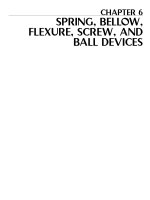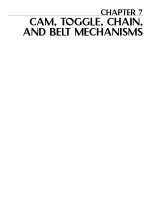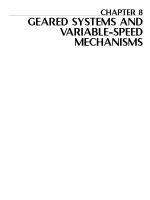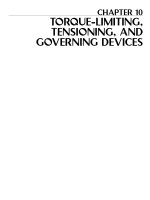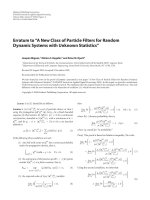EN 143 2021 Respiratory protective devices Particle filters Requirements, testing, marking
Bạn đang xem bản rút gọn của tài liệu. Xem và tải ngay bản đầy đủ của tài liệu tại đây (7.8 MB, 17 trang )
EN 143
EUROPEAN STANDARD
NORME EUROPEENNE
February 2021
ICS 13.340.30
Supersedes EN 143:2000
English Version
Respiratory protective devices - Particle filters Requirements, testing, marking
Appareils de protection respiratoire - Filtres a
particules - Exigences, essais, marquage
Atemschutzgerate - Partikelfilter - Anforderungen,
Priifung, Kennzeichnung
This European Standard was approved by CEN on 4 January 2021.
CEN members are bound to comply with the CEN/CENELEC Internal Regulations which stipulate the conditions for giving this
European Standard the status of a national standard without any alteration. Up-to-date lists and bibliographical references
concerning such national standards may be obtained on application to the CEN-CENELEC Management Centre or to any CEN
member.
This European Standard exists in three official versions (English, French, German). A version in any other language made by
translation under the responsibility of a CEN member into its own language and notified to the CEN-CENELEC Management
Centre has the same status as the official versions.
CEN members
are the national standards bodies of Austria, Belgium, Bulgaria, Croatia, Cyprus, Czech Republic, Denmark,
Estonia,
Finland, France, Germany, Greece, Hungary, Iceland, Ireland, Italy, Latvia, Lithuania, Luxembourg, Malta, Netherlands, Norway,
Poland, Portugal, Republic of North Macedonia, Romania, Serbia, Slovakia, Slovenia, Spain, Sweden, Switzerland, Turkey and
United Kingdom.
ng:
EUROPEAN COMMITTEE FOR STANDARDIZATION
COMITÉ EUROPÉEN DE NORMALISATION
EUROPAISCHES KOMITEE FUR NORMUNG
CEN-CENELEC
© 2021CEN
Management
Centre:
Rue de la Science 23,
Allrights of exploitation in any form and by any means reserved
worldwide for CEN national Members.
B-1040
Brussels
Ref. No. EN 143:2021E
EN 143:2021 (E)
Contents
Page
EUTOPeGan fOPEWOTKC...csssscsecscesssessseseseeeeecesosseseseeeeseeeeseeeeeeesecacaeaeaeaeseeeeeseaesesesesaeeeacaraeaeaeseseseseaesesesanaratararoeosoeeeseseseanses 3
1
SCOPEC vesessssessesessesesesneeseesaesesesaeseesseneneeneaseeseeaessensaeseaesaeaeseeaeesesaeaeaeseeseseseeaeeeaeeaeeeseeaeessesaeaeseueeaeseseeaseeseeaseesneaeeesaeaes 4
2
Normative reference 177070 n.ẽẽẽốố.........................
3
Terms, definitions and syImS...............................«-«s«cesessxskekskstsrsrstsrstsrsrsrsrrsrsrsrsrnrsrsrsrsrsrsrrsrsrsrsrrsrsrsrsrsre 4
4
E130
5
DeSiðTnatÏOH.............................--
6
6.1
R€QUT€ITTIES..........................-..
<< 5< S< sang HHATHHEHEEREEEAERERSESEEERSEEEEESEEIEESESEEESSHEEEEESEEIEEESEEEESEAIEE 7
02:10 ....................................... 7
3.1
3.2
4
TeErMs ANA Cefinitions 17777 6 .......................... 4
SyImbOÏS. . . . . . . . . . . . . . .-.-«- sk
se SE
HHmHHHHHHHHHHHHHTHHHHHERESESESEEEEEEEEEEEHEESESESESEEEEEEEEEEEEESESESEEESE 5
1...
...................................
6
«<5 ssesknn HH HHRRHRHRHHHHHHEHHHEEREESESHEEEEEEEEESESEEHEEEEEEEEREEEESEESEEEESESESiiEEEE 6
6.2
Mi) c0iJ vs
6.3
06001000 ỏi
1770 ...........................
7
07 ...................................
7
6.6
6.7
..........................................
7
Twin or multiple filter VẽCâS...............................côcsesesesekskskeksrrsrsrsrirrrrrrrrrrsrsrsrsrsrsrsrsrsrsrsrsrsrsrsrsnrsrsrsrsre 7
DeSI QD) ..eesssssssseeeesesnenseeeereneeeeeneeneseeeneeaeaearseeeeeeeeeeseeeseseeecaearaeaeaeeeeeeeneneseeeneseuecaeaeaeaeaeeeeeeeneaeaeeeseneeauereeeeeorereeseneneaess 8
6.8
6.4
ETOTIOIMNẽCS.........................
6.5
E1.
ô5< sessESEE=EEEEEAEEkEEEAEEEEEEEEEEEEEAEEEEEAEEEESEAEERSESEEERSESEEEESEEIEESESEEESSHEEEEESEEEIEEESEIEEESESIEE 7
6.9
6.10
G.10.11
6.10.2_
Matte TT h....................................
PaCkBẽNB............................-c
TITIDTaVUTâ..............................-c5 Sk E2
Hang HH HRRAREEEESESEEESEESEEEEESEEESSESEEEEEESEEESESTSEESSESESESESEE
Mechanical strengtth................................-.---ô-ôcseseskekssrersrsrrsExEkiierrrkEsHErxsEHBrsrsHirxrsrsinxrsrke
8
15H
cỡc i6 c7
8
6.12
Filter penetratẽOI...................................ôôexsseskskrsrsskeEskksrsrsrsrrkrrrrrersrsrsrsrsrrrrsrrrreenrsrsrrsrrssrxrsrrsre 9
7
'TâSẽNE.....................-..c
7.1
'TS{ DGTOTINATCC.........................
r.
nh ...........................
HH
HH HH
8
8
8
8
HH HHTHTHHEEREEEEESESEEEIEEREREEEESEEEEESESEEEESEEEEESESEEEEEEEESEEEESEEEESEEEEEk 9
**xkstststsrirrskrrkrrrrsrsrsrsrrrrrsrsssrsnsrsrsTTrxrrnrsrsrsrsrsrsrszsrsrsre 9
in
9
rà PÄNY[
7.2
7.3
7.4
TAL
7.4.2
si
Asia 17 ...........................
W 8a
7n .................................
ÍISD€CÏOIN...............................c«=
CONdÏtÏOnÏTE............................<< sssserHHHHHHHHHHHHHHHHHHHHHHEHETTERERREREHEEEEEESESHEHEEESEEEESESESESEAEEESES
T€IMD€TAUF.................................e«sSsSnsSSnHYHHgH
HH HH RERSREEESESEERSEAESEESESEEEESESEEESESESEESEESEESEESESESiSEiii
Mechanical strengtth...................................--«-esssesesesesrsrseiiieeEeikkkksEsEsEEBBEHESESESEEEETSESEAiirsrsrir
9
10
11
11
11
11
7.5
ii ÌP(0(0(8v13)L1
e1
1n
12
8
Making............................- «s
8.1
011x107. ........................................
13
8.2
li
13
9
Information supplied by the manufaCẨUTT.............................--55-5 ssesesesesesrkrkreekskeksrsrsrsrsrsrrraiirraree 14
8.3
1h.
Filter DaCB...........................
ẽốẽ
ẽốố........................
.ẽẽ....................................
sen HHHHHHH.HHHHHHTT.ERERREHEEEEEEERHEEEEESEEEESESESESEEEEESSHEii 13
Annex ZA (informative) Relationship between this European Standard and the essential
health and safety requirements of Regulation 2016/425/EU [2016 OJ L81] aimed to
De COVELL. ..ecsssssssssssssseeeseseseseenesseneneeseeeeseseseenenseseaeanaueneeeeeeseasacecenseeseseseecaeeneeeaeaeasaceneeseeseneeaseneneasseneerseenensans 15
Biblio gra phy.....sssscscssssssessesessessssesssseseseeseseesseesseseseeseeeseseseaeaeeesessseseeseaeeceneneneaeseaceceaenseeseseaeaceneaeeeseseeeanacensesseneananeneneneees 17
EN 143:2021 (E)
European foreword
This document (EN 143:2021) has been prepared by Technical
protective devices”, the secretariat of which is held by DIN.
Committee
CEN/TC 79 “Respiratory
This European Standard shall be given the status of a national standard, either by publication of an
identical text or by endorsement, at the latest by August 2021, and conflicting national standards shall
be withdrawn at the latest by August 2021.
Attention is drawn to the possibility that some of the elements of this document may be the subject of
patent rights. CEN shall not be held responsible for identifying any or all such patent rights.
This document supersedes EN 143:2000, EN 143:2000/A1:2006 and EN 143:2000/AC:2005.
The following main technical changes have been made compared to EN 143:2000:
a)
definitions and symbols added;
b)
description deleted;
c)
nominal values and tolerances changed;
d)
use of arisk assessment, e.g. a Failure Modes and Effect Analysis (FMEA) added;
e)
twin filters added;
f)
clogging deleted;
g)
visual inspection changed to inspection and detailed list inserted;
h)
filter penetration test changed to refer to EN 13274-7;
i)
marking changed to filters in general;
j)
all figures adapted to the changes made in the test procedures, where appropriate.
This document has been prepared under a mandate given to CEN by the European Commission and the
European Free Trade Association, and supports essential requirements of EU Directive(s).
For relationship
document.
with
EU
Directive(s),
see informative
Annex ZA, which
is an integral part of this
According to the CEN-CENELEC Internal Regulations, the national standards organisations of the
following countries are bound to implement this European Standard: Austria, Belgium, Bulgaria,
Croatia, Cyprus, Czech Republic, Denmark, Estonia, Finland, France, Germany, Greece, Hungary, Iceland,
Ireland, Italy, Latvia, Lithuania, Luxembourg, Malta, Netherlands, Norway, Poland, Portugal, Republic of
North
Macedonia,
United Kingdom.
Romania,
Serbia,
Slovakia,
Slovenia,
Spain,
Sweden,
Switzerland,
Turkey
and
the
EN 143:2021 (E)
1
Scope
This document specifies particle filters for use as replaceable components in unassisted respiratory
protective devices (RPD) with the exception of escape devices and filtering face pieces.
Laboratory tests are included for the assessment of compliance with the requirements.
Some filters complying with this document can also be suitable for use with other types of respiratory
protective devices and/or escape devices. If so, they need to be tested and marked according to the
appropriate European Standard.
This document does not cover requirements concerning respiratory hygiene. Requirements for
decrease of the microbiological hazards caused by the growth of bacteria and viruses on the filtration
material are not determined.
2
Normative references
The following documents are referred to in the text in such a way that some or all of their content
constitutes requirements of this document. For dated references, only the edition cited applies. For
undated references, the latest edition of the referenced document (including any amendments) applies.
EN ISO 16972:2020, Respiratory protective devices - Vocabulary and graphical symbols (ISO 16972:2020)
EN 134:1998, Respiratory protective devices - Nomenclature of components
EN 148-1:2018,
connection
Respiratory
protective
devices
- Threads for facepieces
- Part
1: Standard
thread
EN 13274-3:2001, Respiratory protective devices - Methods of test - Part 3: Determination of breathing
resistance
EN 13274-7:2019, Respiratory protective devices - Methods of test - Part 7: Determination of particle filter
penetration
3
Terms, definitions and symbols
3.1 Terms and definitions
For the purposes of this document,
EN 134:1998 and the following apply.
the
terms
and
definitions
given
in EN ISO 16972:2020
ISO and IEC maintain terminological databases for use in standardization at the following addresses:
—
ISO Online browsing platform: available at />
—
IEC Electropedia: available at />
3.1.1
as received
not pre-conditioned or modified to carry out a test
[SOURCE: EN ISO 16972:2020, definition 3.16]
and
EN 143:2021 (E)
3.1.2
ready for assembly state
component with seals, plugs or other environmental protective means, if applicable, still in place
[SOURCE: EN ISO 16972:2020, definition 3.195]
3.1.3
ready for use state
respiratory protective device (RPD) ready to be donned as described by the manufacturer
Note 1 to entry:
can be necessary.
In line with the information supplied by the manufacturer for donning the RPD, further actions
[SOURCE: EN ISO 16972:2020, definition 3.198]
3.2 Symbols
For the purposes of this document, the following symbols apply.
3.2.1
©
I
See information supplied by the manufacturer
3.2.2
Crossed out 2: Symbol “for single shift use only”
NOTE:
During one shift multiple use is allowed.
3.2.3
Hour glass “end of shelf life”
YYYY-MM
Key: YYYY = year, MM = month
EN 143:2021 (E)
3.2.4
+xx°C
uA
Temperature range of storage conditions
Key: -xx °C to +yy °C
3.2.5
ẳ«
“ạ
“ø «
2
Maximum humidity of storage conditions
Key: < xx %
3.2.6
Filters to be used with a full face mask but not to be connected directly to a half mask
3.2.7
Twin or multiple filters
4
Classification
Particle filters are classified according to their filtering efficiency. There are three classes of particle
filters:
P1, P2 and P3 in ascending order of the filtering efficiency.
The protection provided by a P2 or P3 filter includes that provided by the filter of lower
5
class or classes.
Designation
Particle filters meeting the requirements of this document shall be designated in the following manner:
Particle filter EN 143, year of this document, filter type, class.
EXAMPLE
Particle filter EN 143:2021 P3.
EN 143:2021 (E)
6
Requirements
6.1 General
All test samples specified in the related test clauses shall meet the relevant requirements.
Where it is required in a specific clause the manufacturer shall declare that a risk assessment, e.g. a
Failure Modes and Effect Analysis (FMEA) has been conducted.
NOTE
Further information is given in EN 60812 [1].
6.2 Values and tolerances
Temperature limits, values which describe test conditions and that are not stated as maxima or minima
shall be subject to a tolerance of+ 5 %. Unless otherwise specified, the ambient conditions for testing
shall be between 16 °C and 32 °C and (50 + 30) % relative humidity.
Any temperature limits specified shall be subject to an accuracy of + 1 °C.
6.3 Connection
The connection between filter(s) and respiratory interface with which it is intended to be used shall be
robust and leaktight.
The manufacturer shall supply a declaration that this was addressed by a risk assessment, e.g. a FMEA.
Threads conforming to EN 148-2 or EN 148-3 shall not be used.
The connection between filter and facepiece may be achieved by a special connector or by a screw
thread including a thread conforming to EN 148-1:2018.
If the filter is designated to be used on a twin or multiple filter facepiece or has any other thread, it shall
not be possible to connect it to a thread conforming to EN 148-1:2018.
The filter shall be readily replaceable without use of special tools and shall be designed or marked to
prevent incorrect assembly.
Check in accordance with 7.3.
6.4 Ergonomics
The requirements of this document are intended to take account of the interaction between the wearer,
the RPD, and where possible the working environment in which the RPD is likely to be used. Filters
shall satisfy the requirements of 6.5, 6.7, 6.8 and 6.11.
Check in accordance with 7.3 and test in accordance with 7.5.
6.5 Mass
The maximum mass of filter(s) designated to be used directly connected to a half mask shall not exceed
300g.
The maximum mass of filter(s) designated to be used directly connected to a full face mask shall not
exceed 500 g and shall be marked with the symbol given in 3.2.6.
Check in accordance with 7.3.
6.6 Twin or multiple filter devices
Where filtering devices are designed to use more than one filter through which the flow is
proportioned, all relevant requirements specified in this document are to be met by the complete set of
filters.
EN 143:2021 (E)
If, however, it is intended that the single filter ofa twin or multiple filter device may be used alone, then
the requirements at the full flow rate for the tests, as stated in this document, shall be met.
In the information supplied by the manufacturer all necessary information
multiple filters shall be given.
on how to use twin or
Testing shall be performed in accordance with 7.1 and checked in accordance with 7.3.
6.7 Design
The surface of any part of the filter likely to come in contact with the wearer shall be free from sharp
edges and burrs.
Check in accordance with 7.3.
6.8 Materials
Materials used shall be suitable to withstand the intended use and conditions, (e.g. temperatures,
humidity and corrosive environments) as stated by the manufacturer unless specified in this document.
The manufacturer shall supply a declaration that this was addressed by a risk assessment, e.g. a FMEA.
Any material of the filter media or any gaseous products that may be released by the air flow through
the filter shall not be known to constitute a hazard or nuisance for the wearer.
The manufacturer shall supply a declaration that this was addressed by a risk assessment, e.g. a FMEA.
Check in accordance with 7.3.
6.9 Packaging
Where appropriate, filters shall be factory sealed in such a way that the breaking of the factory sealing
can be identified.
Check in accordance with 7.3.
6.10 Conditioning
6.10.1
Temperature
Filters in their ready for assembly state shall be subjected to the temperature
accordance with 7.4.1 and shall meet the requirement of the relevant clauses.
6.10.2
conditioning
in
Mechanical strength
Filters in their ready for assembly state as specified by the manufacturer shall be subjected to the
mechanical strength with a total number of 2 000 rotations in accordance with 7.4.2 and shall meet the
requirement of the relevant clauses.
Un-encapsulated filter(s) shall be
commercially available package.
subjected
to the test in accordance
with
7.4.2
in the
smallest
6.11 Inhalation resistance
The resistance imposed by filter(s) to the flow of air shall be as low as possible and in no case exceed
the values shown in Table 1.
Three filters shall be tested, after the temperature conditioning in accordance with 7.4.1 followed by
mechanical strength conditioning in accordance with 7.4.2.
Testing shall be performed in accordance with 7.5.
EN 143:2021 (E)
Table 1 — Maximum
Filter class
inhalation resistance
Maximum
inhalation resistance
in hPa
at 30 1/min
at 95 1/min
with a tolerance of + 2% | witha tolerance of + 2%
P1
0,6
P2
P3
2,1
0,7
1,2
2,4
4,2
6.12 Filter penetration
The requirements for maximum filter penetration are given in Table 2.
Table 2 — Maximum filter penetration
Maximum filter penetration of test aerosols
(%)
Filter class
Sodium chloride test
Paraffin oil test
at 95 1/min
at 95 1/min
with a tolerance of + 2% |
with atolerance of + 2 %
P1
20
20
P2
6
6
P3
0,05
0,05
For each aerosol, three filters shall be tested, after the temperature conditioning in accordance with
7.4.1 followed by the mechanical strength conditioning in accordance with 7.4.2.
Testing shall be performed in accordance with EN 13274-7:2019, 5.4 and 5.5.
7
Testing
7.1 Test performance
7.1.1 General
Tests for the filters not having a connector in accordance with EN 148-1:2018 shall be performed using
a Suitable filter interface supplied by the manufacturer.
7.1.2 Test flow conditions
All tests shall be performed with the test air or test aerosol pass through the filter horizontally, unless
otherwise specified.
When one filter of a twin or multiple filter device is tested separately, the air flow specified for a test
shall be divided by the appropriate number through which the air flow is proportioned. If, however, it is
possible that one filter of a twin or multiple filter device may be used alone, then the full air flow shall
be used for testing.
If the filters’ resistance meets Formula (1) the filter may be tested as a single filter with a proportioned
flow. If the filters’ breathing resistances do not meet that formula, the filters shall be tested in a
complete unit at the full flow rate.
EN 143:2021 (E)
(1)
where
l4;
max
mfr
is the maximum
difference between all tested filters;
is the mean flow resistance.
When testing one filter of a twin or multiple filter device with the proportioned
appropriate performance requirements shall be met.
test air flow, the
All results of measured air flow rates are deemed to be volumetric flow rates and shall be corrected to
20°C, 1 013 hPa according to Formula (2).
(2)
where
Qcor
is the corrected air flow;
Qm
is the measured air flow;
k
is aconstant 0,289 [K/hPa], ie. 293 K divided by 1 013 hPa (20°C);
Pm
is the pressure during measurement in hPa;
Tm
is the temperature during measurement in K.
7.2 Test schedule
The test schedule is given in Table 3.
Table 3 — Testing schedule
Requirement
6.3
6.5
|
Title
Number of
test samples
Connection
Mass
Conditioning
Test clause
3
as received
7.3
3
as received
7.3
Inhalation
6.11
6.12
a
resistance
Filter
penetration
Associated
requirements
BN 148-1
(if applicable)
EN 13274-3:2001,
3
3 (for each
aerosol)
7.4.1 and 7.4.2
74.1 and 7.4.2
75
Clause 6, Method 1
EN 13274-7:2019,
5.4 and 5.5
Most samples are used for more than one test.
Before performing tests involving human subjects account shall be taken of any national regulations
concerning the medical history, examination or supervision of the test subjects.
If no special measuring
devices shall be applied.
10
devices or measuring methods
are specified, commonly
used methods
and
EN 143:2021 (E)
7.3 Inspection
The inspection shall be made prior to laboratory tests or where specified in this document.
This can entail weighing and a certain amount of assembly, dismantling or adjustment of the filter(s).
The inspection shall include a report of the findings of the following:
a)
visible damages, deformation, corrosion;
b)
if connections can be disconnected inadvertently;
c)
ifincorrect combinations are prevented by design solutions;
d)
marking;
e)
total mass of the filter(s);
f)
information supplied by the manufacturer;
g)
if handling can be done without use of special tools, as required;
h)
if means for sealing will be retained in position, unless deliberately removed for maintenance;
i)
compatibilities with other parts of respiratory protective devices;
j)
documentation, e.g. safety data sheets and a declaration that a risk assessment, e.g. a FMEA has
been conducted in relation to the materials used in its design and that the connection between filter
and RPD is robust and leaktight.
7.4 Conditioning
7.4.1 Temperature
The filter in its ready for assembly state shall be pre-conditioned in accordance with the following
thermal cycle
a)
dry atmosphere (less than 20 % relative humidity) at a temperature of (70 + 3) °C for (24+0,1)h
and
b)
atatemperature of (-30 + 3) °C for (24+0,1)h
and shall then return to room temperature for at least 4 h between exposures and prior to subsequent
testing.
In order to ensure that there is no temperature shock during the conditioning of the samples, the
temperature gradient shall be less than 2°C/min between phases at different temperatures, and
between the beginning and the end of a thermal cycle.
7.4.2 Mechanical strength
7.4.2.1 Test equipment
The test apparatus is shown schematically in
vertically moving piston (4) capable of being
on to a steel plate (3) under its own mass as
10 kg and the base of the equipment should
bolted on a solid floor.
Figure 1 and consists
lifted up 20 mm by a
the cam rotates. The
either weigh at least
of a steel case (1) which is fixed ona
rotating cam (5) and dropping down
mass of the steel case shall be over
10 times as much as the case, or be
11
EN 143:2021 (E)
7.4.2.2 Test procedure
The test samples (2) shall be placed in the steel case (1) so that they do not touch each other during the
test, allowing (6 + 2) mm horizontal movement and free vertical movement. The test samples shall be
placed in the steel case with the main air flow axis horizontal. After the test any loose material that may
have been released from the filter shall be removed prior to the performance testing.
The test apparatus
shall be operated at the rate of approximately
(100 +5)
r/min for the required
number of rotations.
>
He
—h
Ì
SN
|
|
ol
T—~
a
1,
Key
1.
steel case
4
piston
2
testsample
5_
rotating cam [capable of lifting the steel case]
3
steel plate
Figure 1 — Typical arrangement for conditioning respiratory protective devices or components
to mechanical stress
7.5 Inhalation resistance
The test method shall be as specified in EN 13274-3:2001, Clause 6, Method 1.
Tests for the filters not having a connector in accordance with EN 148-1:2018 shall be performed using
a suitable filter interface supplied by the manufacturer.
Testing shall be carried out at two flow rates (30 1/min with a tolerance of+ 2 % and 95 l/min with a
tolerance of+ 2% continuous flow or proportioned as appropriate) at a humidity that condensation
does not occur.
The resistance values shall be corrected for the resistive value introduced by the interface supplied by
the manufacturer.
1 013 hPa.
12
The flow rate at which the resistance is measured,
shall be corrected to 20 °C and
EN 143:2021 (E)
8
Marking
8.1 General
Sub-assemblies and components with considerable bearing on safety shall be marked so that they can
be identified.
If sub-assemblies with considerable bearing on safety are too small to be marked, the information shall
be given in the information supplied by the manufacturer.
Check in accordance with 7.2.
8.2 Filters
a)
All filters where the filtering material is contained within a casing shall be marked with the number
and year of this document and followed by the appropriate filter type and class (P1, P2 or P3), and
white colour code.
EXAMPLE
EN 143:2021 P3
If the marking is not directly printed on the filter body, it shall be on a white colour coded label
affixed to the filter body. In this case, the colour of the body shall not be considered to be the colour
code.
Silver or light metal colour shall not be regarded as white.
b)
Type-identifying mark.
c)
Amark showing if the filter is for a twin or multiple filter device (see 3.2.7).
d)
Year and month of expiry of shelf life or the appropriate symbol (see 3.2.3).
e)
The manufacturer’s name, trade mark or other means of identification.
f)
The symbol “See information supplied by the manufacturer” (see 3.2.1).
g)
Filters for full face mask only (see 3.2.6).
8.3 Filter package
The smallest commercially available filter package shall be marked at least with the following
information, unless it is already on the filter and the information is visible without opening the package.
a)
The number and year of publication of this document followed by the appropriate filter type and
class (P1, P2 or P3), and white colour code.
EXAMPLE
EN 143:2021 P3
b)
The year and the month of end of shelf life or the appropriate symbol (see 3.2.3), if applicable.
c)
The manufacturer’s name, trade mark or other means of identification.
d)
Type-identifying mark.
e)
The sentence
3.2.1).
“See information
supplied
by the manufacturer”
or the appropriate
symbol
(see
13
EN 143:2021 (E)
The manufacturers recommended conditions of storage (at least the temperature and humidity)
using the appropriate symbols (see 3.2.4 and 3.2.5).
8)
A mark showing if the filter is for a twin or multiple filter device using the appropriate symbol (see
3.2.7).
h)
Filters for full face mask only (see 3.2.6).
9
Information supplied by the manufacturer
The information supplied by the manufacturer shall:
a)
accompany every smallest commercially available package;
b)
contain all information necessary for trained and qualified persons on:
1)
application, intended use, limitations;
2)
type-identifying marking to ensure that the filter can be identified;
3)
checks prior to use;
4)
assembling, e.g. how the filter(s) is (are) inserted in the equipment for which it is (they are)
designed and how that equipment is identified;
5)
disposal;
be clear and comprehensible. If helpful, illustrations, part numbers, marking may be added;
d)
include warnings against problems likely to be encountered, for example:
1)
hazards of oxygen deficiency;
2)
hazards of oxygen and oxygen-enriched air;
3)
air quality;
4)
use of equipment in explosive atmosphere;
5)
storage under conditions other than those specified by the manufacturer that can affect the
shelf life;
6)
guidance how to use filter(s) with both full face masks or half masks, or not with half masks as
appropriate (weight of filter);
inform the user that special attention should be given
concentration environments when selecting the filter(s);
to highly
toxic
substances
contain an explanation of the symbols used;
8)
contain a means of the manufacturer’s name, trade mark or other means of identification;
h)
contain the number and year of publication of this document.
14
and
high
EN 143:2021 (E)
Annex ZA
(informative)
Relationship between this European Standard and the essential health and
safety requirements of Regulation 2016/425/EU [2016 OJ L81] aimed to be
covered
This European Standard has been prepared under a Commission’s standardization request to provide
one voluntary means of conforming to essential requirements of Regulation 2016/425/EU of the
European Parliament and of the Council of 9 March 2016 on personal protective equipment and
repealing Council Directive 89/686/EEC [2016 OJ L81].
Once
this
standard
is
cited
in
the
Official
Journal
of the
European
Union
under
that
Directive,
compliance with the normative clauses of this standard given in Table ZA.1 confers, within the limits of
the scope of this standard, a presumption of conformity with the corresponding essential health and
safety requirements of that Directive, and associated EFTA regulations.
Table ZA.1 — Correspondence between this European standard and Article 3 of Regulation
2016/425/EU [2016 OJ L81]
Essential health and safety requirements of
Regulation 2016/425/EU
Clause(s) /subclause(s)
of this EN
1.1.1 Ergonomics
6.4, 6.5
1.1.2.1 Optimum level of protection
6.5, 6.12
1.1.2.2 Classes of protection appropriate to different
levels of risk
6.12
1.2.1.1 Suitable constituent materials
6.8
1.2.1.2 Satisfactory surface condition of all PPE
parts in contact with the user
67
,
1.3.2 Lightness and design strength
6.3, 6.5, 6.10
1.4 Information supplied by the manufacturer
9
2.4 PPE subject to ageing
8.2 d), 8.3 b)
2.9 PPE incorporating components which can be
adjusted or removed by the user
63
2.12 PPE bearing one or more identification or
recognition marks directly or indirectly relating to
health and safety
8
3.10.1 Respiratory protection
6, 8,9
Qualifying
remarks/Notes
WARNING 1 — Presumption of conformity stays valid only as long as a reference to this European
standard is maintained in the list published in the Official Journal of the European Union. Users of this
standard should consult frequently the latest list published in the Official Journal of the European
Union.
15
EN 143:2021 (E)
WARNING 2 — Other Union legislation may be applicable to the product(s) falling within the scope of
this standard.
16
EN 143:2021 (E)
Bibliography
EN 60812:2006, Analysis techniques for system reliability - Procedure
for failure mode and effects
analysis (FMEA)
EN 148-2, Respiratory protective devices - Threads for facepieces - Part 2: Centre thread
connection
EN 148-3, Respiratory protective devices - Threads for facepieces - Part 3: Tread connection
M45x3
17

